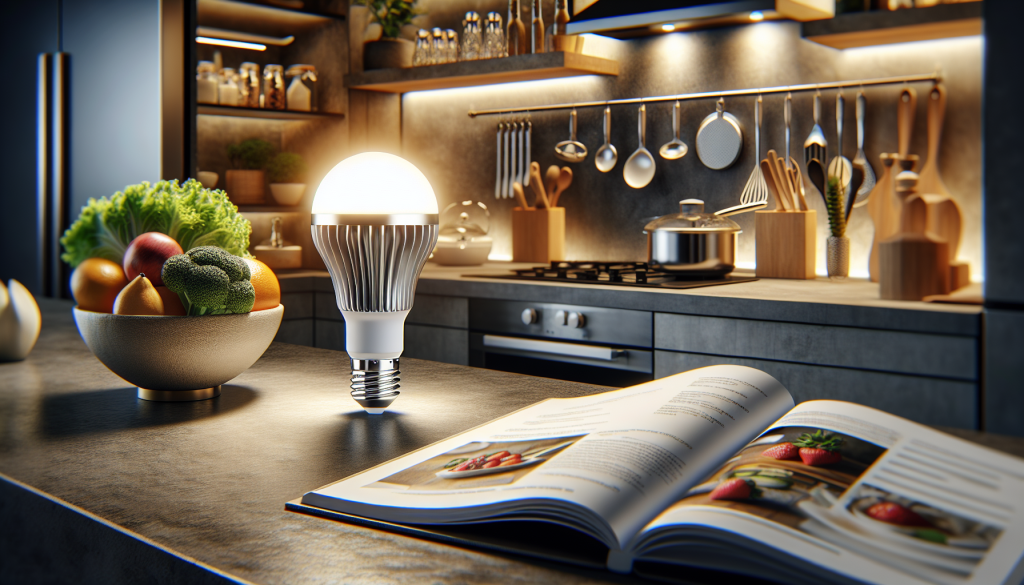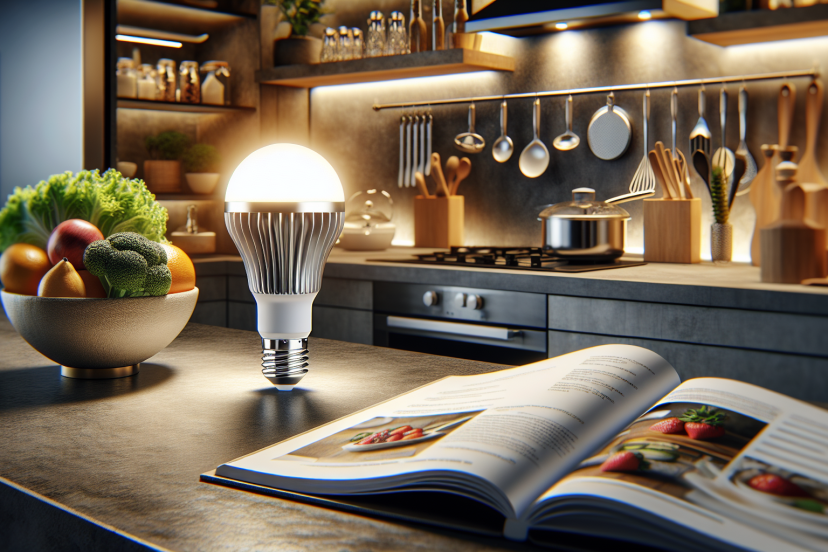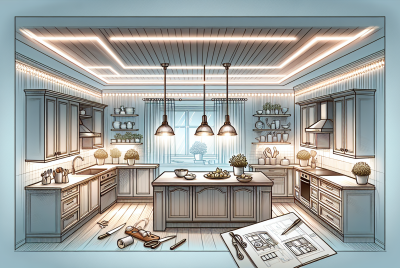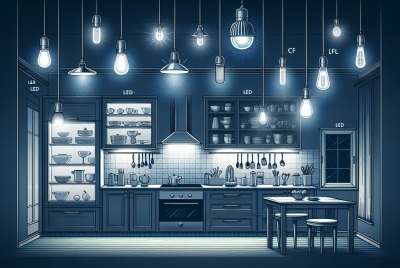Key Factors To Consider When Selecting LED Kitchen Lighting
You’re on a mission to upgrade your kitchen lighting and are considering LED options. But with so many choices out there, it can be overwhelming to figure out where to start. Look no further! In this article, we’ll highlight the key factors you need to consider when selecting LED kitchen lighting. From brightness and color temperature to energy efficiency and installation, we’ll guide you through the decision-making process, making sure you choose the perfect LED lights that not only illuminate your kitchen but also enhance its overall aesthetic. Say goodbye to bland and outdated lighting, and say hello to a bright and inviting space!
Brightness
Lumens
When choosing LED kitchen lighting, one of the key factors to consider is brightness. Lumens are the units of measurement used to quantify the brightness of a light source. The higher the lumen count, the brighter the light will be. It is important to select LED lights that provide adequate illumination for your kitchen space. Consider the size of your kitchen and the tasks you regularly perform in the area when determining the ideal lumen count for your LED kitchen lights.
Color Temperature
Another aspect of brightness to consider is the color temperature of the LED lights. Color temperature refers to the appearance of light in terms of warm or cool tones. It is measured in Kelvin (K). LED lights with a lower color temperature, around 2700K-3000K, produce a warm yellowish light similar to traditional incandescent bulbs. On the other hand, LED lights with a higher color temperature, around 4000K-5000K, emit a cooler, bluish light. When selecting LED kitchen lighting, consider the ambiance you want to create and the overall look and feel of your kitchen.
Energy Efficiency
Wattage
Energy efficiency is another crucial factor to consider when choosing LED kitchen lighting. Wattage measures the power consumption of a light bulb. LED lights are known for their energy efficiency, as they require less wattage to produce the same amount of light as traditional incandescent bulbs. By choosing LED lights with lower wattage, you can significantly reduce your energy consumption and lower your electricity bills. Look for LED lights that provide sufficient brightness while consuming minimal wattage.
Energy Star Certification
To ensure maximum energy efficiency, look for LED lights that are Energy Star certified. Energy Star is a program run by the U.S. Environmental Protection Agency (EPA) and the U.S. Department of Energy (DOE) that aims to promote energy-efficient products. LED lights with Energy Star certification meet strict guidelines for energy efficiency, performance, and quality. By choosing Energy Star certified LED kitchen lighting, you can be confident that you are selecting a product that will save energy and reduce your carbon footprint.

Color Rendering Index (CRI)
In addition to brightness and energy efficiency, the color rendering index (CRI) is another important factor to consider when selecting LED kitchen lighting. The CRI measures how accurately a light source reveals the true colors of objects. It is measured on a scale of 0 to 100, with a higher CRI indicating better color accuracy. For kitchen environments, where you may be preparing and cooking food, it is crucial to have LED lights with a high CRI to accurately distinguish between different ingredients and ensure your cooking is done to perfection. Look for LED lights with a CRI of 80 or higher for optimal color rendering.
Lighting Direction
Ambient Lighting
Ambient lighting refers to general, overall illumination in a space. In the kitchen, ambient lighting is essential for creating a comfortable and inviting atmosphere. LED lights that provide ambient lighting should be evenly distributed to ensure consistent illumination throughout the kitchen. Consider installing LED recessed lights or flush mount lighting fixtures on the ceiling to achieve a uniform ambient lighting effect.
Task Lighting
Task lighting is designed to provide direct and focused illumination for specific tasks or activities in the kitchen. It is particularly important in areas where you perform detailed tasks such as food preparation or reading recipes. LED under cabinet lighting is a popular choice for task lighting in the kitchen as it provides targeted illumination on countertops and workspaces. Pendant lighting above kitchen islands or peninsulas can also serve as effective task lighting.
Accent Lighting
Accent lighting adds depth, visual interest, and highlights specific areas or objects in your kitchen. It can be used to showcase artwork, architectural features, or decorative items. LED spotlights or track lighting fixtures are commonly used for accent lighting, allowing you to direct light precisely where you want to draw attention. Accent lighting can enhance the overall aesthetic of your kitchen and create a warm and inviting ambiance.

Dimming Capability
Dimming capability is an important feature to consider when selecting LED kitchen lighting. Dimmable LED lights offer the flexibility to adjust the brightness according to your needs and preferences. Whether you want to create a cozy atmosphere for a romantic dinner or you need brighter lighting for food preparation, dimmable LED lights allow you to easily control the lighting levels in your kitchen. Check for compatibility with dimmer switches or consider investing in smart lighting systems that offer advanced dimming capabilities.
Fixture Style
Under Cabinet Lighting
Under cabinet lighting is a popular fixture style for kitchens as it provides localized illumination for countertops and work areas. LED under cabinet lights are typically installed beneath upper cabinets and are available in various styles, such as strip lights or puck lights. These fixtures not only enhance visibility but also add a touch of modern elegance to your kitchen.
Recessed Lighting
Recessed lighting is a sleek and minimalist fixture style that blends seamlessly with any kitchen decor. These lights are installed into the ceiling, creating a clean and unobtrusive look. LED recessed lights are energy-efficient and provide uniform illumination throughout the kitchen. They are particularly suitable for ambient lighting or as Task lighting in specific areas.
Flush Mount Lighting
Flush mount lighting fixtures are a practical and versatile option for kitchen lighting. These fixtures are mounted flush against the ceiling, providing direct and widespread illumination. LED flush mount lights are available in a variety of styles, from simple and understated to decorative and ornate, allowing you to choose a fixture that complements your kitchen’s aesthetic.
Pendant Lighting
Pendant lighting adds a touch of elegance and style to any kitchen. These fixtures hang from the ceiling and typically feature one or several light sources enclosed in a decorative shade or glass. LED pendant lights are not only visually appealing but also provide focused lighting for kitchen islands or dining areas. They can serve as both ambient and task lighting, depending on the design and placement.
Lighting Controls
Wall Switches
Wall switches are a simple and convenient way to control your LED kitchen lighting. By using wall switches, you can easily turn lights on or off without the need for additional devices. Consider installing dimmer switches that allow you to adjust the brightness levels according to your preferences. Wall switches are a classic and reliable lighting control option.
Smart Lighting Systems
For enhanced control and convenience, consider incorporating smart lighting systems into your kitchen. Smart lighting systems allow you to control your LED lights using your smartphone, voice commands, or automated schedules. You can adjust brightness levels, change colors, and even create customized lighting scenes to match different occasions or moods. With smart lighting, you have the flexibility to personalize your lighting experience and easily integrate your kitchen lighting with other smart home devices.
Longevity
Lifespan
LED lights are known for their long lifespan compared to traditional incandescent or fluorescent bulbs. When selecting LED kitchen lighting, consider the lifespan of the lights to ensure long-term durability and cost-effectiveness. LED lights typically have an average lifespan of 25,000 to 50,000 hours, which means they can last for several years without needing frequent replacements. Investing in LED lights with a longer lifespan will save you money in the long run and reduce the hassle of constantly changing bulbs.
Warranty
To ensure peace of mind and protect your investment, check the warranty offered by the manufacturer of the LED lights. A longer warranty indicates that the manufacturer has confidence in the quality and durability of their product. Look for LED lights that come with a warranty of at least three years or more. A reliable warranty will cover defects, premature failures, and provide support in case you encounter any issues with your LED kitchen lighting.
Price
Price is undoubtedly an important consideration when selecting LED kitchen lighting. LED lights tend to have a higher upfront cost compared to traditional lighting options. However, it is essential to consider the long-term savings and benefits that LED lights offer. LED lights consume less energy and have a longer lifespan, resulting in lower electricity bills and fewer replacements. When considering the price, evaluate the overall value, energy efficiency, and durability of the LED lights to make an informed decision.
Compatibility
Compatible with Existing Infrastructure
Lastly, when choosing LED kitchen lighting, consider the compatibility of the lights with your existing infrastructure. Check the size, shape, and dimensions of the fixtures to ensure they can be easily installed in your kitchen without any modifications. Additionally, if you have existing dimmer switches or smart home systems, verify if the LED lights are compatible with those controls. Ensuring compatibility will make the installation process smoother and ensure that the LED lights seamlessly integrate into your kitchen setup.
In conclusion, selecting LED kitchen lighting involves considering multiple factors to ensure optimal brightness, energy efficiency, lighting direction, dimming capability, fixture style, lighting controls, longevity, price, and compatibility. By carefully evaluating these factors and understanding your specific needs and preferences, you can choose LED lights that enhance the functionality, ambiance, and aesthetic appeal of your kitchen while saving energy and providing long-lasting performance.




